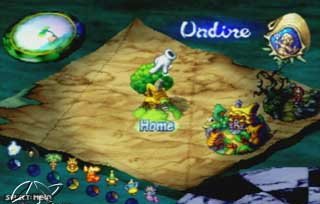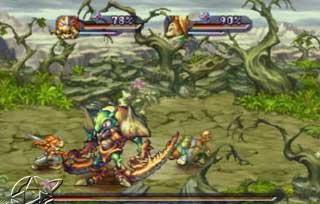 |
Legend of Mana - Review |
 |
Different is Good
By: Andrew P. Bilyk
| Review Breakdown |
| Battle System |
7 |
| Interface |
8 |
| Music/Sound |
8 |
| Originality |
10 |
| Plot |
6 |
| Localization |
10 |
| Replay Value |
9 |
| Visuals |
9 |
| Difficulty |
Medium |
| Time to Complete |
20 - 60 Hours
|
|
| Overall |
 |
| Criteria
|
For many an RPGamer, Square's Seiken Densetsu series is a treasured favorite; an old friend that will always be held dear. The action-RPG series was first introduced to North American gamers in 1991 as Final Fantasy Adventure, one of the Game Boy's first role playing games. Fans were reacquainted with their familiar friend in 1994's SNES masterpiece Secret of Mana. The third component of the series, Seiken Densetsu 3, never officially found its way to our shores, leaving many players upset and lonely for their old companion. After six years of waiting, our long-time pal finally makes a return trip to North America as its fourth incarnation: the PlayStation title, Legend of Mana.
Although fans are certainly glad to be reunited with their acquaintance of old, this isn't the same companion we used to know. Just like you, me, and the rest of the video gaming industry, the Seiken Densetsu series has changed in many, many ways since our last encounter; and those expecting Legend of Mana to be an updated version of Secret of Mana will surely face disappointment. However, gamers should fear not. Even though our aged compadre is different than we remember, those who look closely enough will find as good a friend as ever in Legend of Mana.
Compared to the battle engines of most other RPGs, Legend of Mana's battle system is a breath of fresh air. As would be expected, battles are action-oriented, featuring a wide array of attack styles and abilities. Normal attacks and slower-yet-stronger "power hits" are the two ever-present abilities that cannot be changed. With the exception of the two default attack styles, the player's line-up of battle abilities is customizable. Players may select any two normal abilities, such as jump and lunge, from a pool of up to 26 skills, as well as any combination of four different magic spells or weapon-specific "special techniques." All of these abilities are performed at the push of a button. In fact, to keep the fighting pace unusually quick, menus are not even available during battle scenes.
Although it shares many similarities with other action-RPGs, Legend of Mana has more than its share of unique traits. The run-anywhere, fight-at-your-leisure combat style of games like Legend of Zelda and Secret of Mana is no more. Instead, enemy encounters are handled much like they are in Square's Chrono Trigger: when on-screen enemies are approached, the game screen locks into place and battle ensues. Enemies are usually encountered in groups of two to five, with the exception of many boss battles, which often feature a single enormous monster. Also, in what may be a first for an action-RPG, the player will begin each battle with full health. Items are not available for use in combat, and running from battles is not an option. Because of these factors, players will not be punished in any way for perishing in battle. In fact, after losing a fight, the player can continue from immediately before the battle took place.

|
| Watch out for the Chobin Hoods
|
|
Legend of Mana's musical score, while not extraordinary, is very well done and pleasing to the ear. The music is clear and crisp with great sounding instrumentals, and well-done vocals are featured in several tracks as well. The game features a wide variety of tracks, with most of the game's locations featuring unique tunes. The music does a good job of transmitting the game's emotion, with deep, solemn pieces for sad events and fast-paced, high intensity tunes for battles. Some tracks are brilliantly composed and will firmly root themselves in your memory, while a few just fade into the background. However, most melodies fall into the happy medium between these two. Legend of Mana's sound effects aren't anything to write home about, but they do fill the job nicely. Footsteps, roaring fires, battle clashes, and every other sound bite are sampled well and come out clearly. Some samples do border on annoyance, but for the most part, the sound effects do nothing but add to the game.
Without question, Legend of Mana is one of the most original RPGs I've ever seen. Most aspects of the game, such as the layout of the world map and the order in which events are played out, are not predefined. Rather, players have the ability to progress through their customized world however they choose, for a unique experience each time. The game's style of storyline progression is completely different from that of the average RPG. The game features nearly 70 "events:" reasonably short tasks that introduce new areas and help progress one of the game's many sub-stories. These events can range from small ten-minute quests in a single location to hours-long searches across numerous areas on the map. Sometimes a non-player character (NPC) will join the player during an event; other times the player will work solo. These events can be played out in a player-decided order, which may in turn affect the availability of later events.
Legend of Mana does not have a single, highly developed plot like most RPGs. Rather, the game focuses on the events of the world as a whole, with its numerous intertwined themes. Most individual sub-plots span across numerous events, although they are certainly not required to be completed in a consecutive order. Nearly all of these sub-stories focus on NPCs, and in fact, the player's character often seems more like an observer than a participant in many scenarios. Although most of Legend of Mana's sub-stories are light-hearted and a bit on the simple side, a few complex and emotional scenarios are present as well. Although the lack of a central plot may at first dishearten some gamers, the smaller plots, although a bit lacking, make for an enjoyable ride and really must be experienced to be appreciated.

|
| A customizable world |
|
Squaresoft really outdid themselves with Legend of Mana's localization. The game has been translated almost perfectly, with the most realistic dialog I've ever seen. Characters feature a wide variety of well-done accents, and the game has virtually no (I only counted two) typos. The menus, item descriptions, character summaries, and the rest of the game's text flows well and is very detailed. Hats off to Square on a great translation, especially considering the larger-than-average amount of text in the game.
Legend of Mana's replay value is extremely high. The game allows the player to choose from one of two characters at the beginning of each game, and the many customizable options help make each experience different. Also, some events and areas can only be accessed during the second time around, as some decisions made during the game will make some events unavailable. Players who give Legend of Mana a second play can also start a new game using all their equipment, items, and status levels from the first game, similarly to the "New Game +" feature of the SNES classic Chrono Trigger.
Legend of Mana boasts what may be the most impressive 2-dimensional graphics ever to grace an RPG. The backgrounds are very highly detailed. The graphics are bright and colorful in most areas, yet dark and moody where appropriate. The characters animate beautifully, with a wide range of actions. Numerous familiar enemies, such as Rabites and Chobin Hoods, make return appearances with graphical updates that don't disappoint. Legend of Mana's boss monsters are the largest, most detailed 2-D sprites I've ever seen, often filling much more than half the screen. Also worth mention are the game's intro and ending FMVs, which are impressive despite their short length.
Legend of Mana's difficulty must be explained from two different aspects of the game. From a battle difficulty point of view, Legend of Mana is painfully easy. Even the most difficult boss can often be defeated without using magic or special techniques, and players will never need to fight for the sole sake of raising levels. Players prone to dying won't have many problems either, as they can continue from right before the battle took place and immediately try again. From an intellectual, puzzle-solving point of view, however, Legend of Mana can be a difficult and often frustrating game. Often the player is given few or no clues as to how to complete an event, which may leave some players on a mindless search for what to do next. Although merely completing the game isn't too difficult a task, finding most of the game's events and areas may prove to be quite a feat for many gamers.

|
| Return of the Mantis Ant |
|
As with any RPG, the time necessary to complete Legend of Mana is variable. Players who cut straight to the chase will most probably be able to finish the game in 20 hours or less. However, to find most of the events and areas without using a strategy guide or other help device may take up to 60 hours of play time, depending on the playing style of the gamer.
Legend of Mana is one of those games that has something for everyone. With so many quests and so many side activities, such as weapon creation and pet raising, Legend of Mana will certainly give players a fantastic bang for their buck. The game may not appeal to every gamer, considering its unique brand of play and sheer difference in style from the rest of the Seiken Densetsu series. However, those who give Legend of Mana a chance are sure to find a truly gratifying, unforgettable experience.
|










